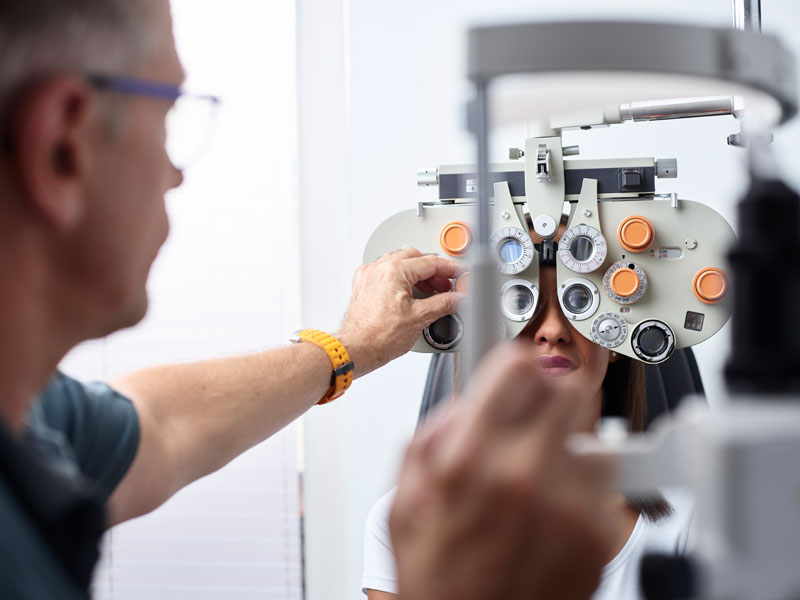Experience Personalized Treatment with Opticore Optometry in Chino
Experience Personalized Treatment with Opticore Optometry in Chino
Blog Article
Discovering the most recent Technical Advancements in Optometry and What They Mean for Optometrists
From the accuracy of Optical Coherence Tomography to the nuanced understandings supplied by AI-driven diagnostic tools, these innovations are setting brand-new standards in person evaluation and treatment. As these innovations permeate the method, eye doctors are encountered with the challenge of welcoming these tools to boost individual end results.
Advancements in Diagnostic Devices
Progressing the field of optometry, developments in diagnostic tools have actually revolutionized the method eye treatment professionals assess and identify ocular conditions and aesthetic disabilities. The past decade has witnessed significant technological advancements, enabling more accurate and comprehensive examinations. Optical Coherence Tomography (OCT), for instance, supplies high-resolution cross-sectional photos of the retina, permitting the very early detection of conditions such as glaucoma and age-related macular degeneration. This non-invasive imaging technique has actually come to be indispensable in contemporary optometric method.
Another trick development is the intro of advanced corneal topography systems, which map the surface curvature of the cornea with accuracy. These tools are specifically valuable for fitting get in touch with lenses and diagnosing corneal disorders. Furthermore, electronic retinal imaging has actually changed traditional ophthalmoscopy, providing comprehensive, breathtaking views of the retina that facilitate thorough aesthetic assessments.
The advancement of wavefront aberrometry has also been crucial, making it possible for the analysis of refractive mistakes with unequaled accuracy (Eye Doctor Optometrist). This innovation helps in tailoring corrective lenses and enhancing medical results for refractive surgical treatments. Collectively, these analysis developments encourage eye doctors to provide superior client care, guaranteeing very early treatment and customized treatment approaches, eventually boosting aesthetic health and wellness outcomes
AI in Patient Administration
Structure on the structure of cutting-edge diagnostic devices, the incorporation of synthetic intelligence (AI) in client administration stands for a transformative leap for optometry. AI systems are significantly employed to boost efficiency, precision, and personalization in patient treatment.
Furthermore, AI-driven platforms assist in structured person interactions and management procedures. Automated organizing, virtual appointments, and personalized follow-up plans not just improve person satisfaction but also enhance time monitoring for specialists. These systems can triage patients based on the necessity of their problems, making sure that those in important need get timely interest.
Furthermore, AI boosts decision-making by offering optometrists with evidence-based suggestions and therapy pathways. By incorporating information from digital health records, AI devices provide insights that notify professional decisions, lowering the risk of errors and improving individual outcomes. As AI remains to develop, its function in individual monitoring will likely expand, reshaping the landscape of optometric care.
Breakthroughs in Retinal Imaging
In the world of optometry, retinal imaging has actually witnessed amazing technical developments that are improving diagnostic abilities and patient care. Innovations such as Optical Comprehensibility Tomography (OCT) and fundus digital photography have transformed exactly how optometrists picture and examine the retina. OCT, specifically, provides high-resolution, cross-sectional images of the retina, permitting the comprehensive evaluation of its layers. This ability is invaluable for very early discovery and administration of problems like glaucoma, diabetic person retinopathy, and age-related macular deterioration.
Improved imaging modalities like OCT angiography are more refining diagnostic accuracy. This non-invasive method maps blood flow in the retina, supplying crucial insights into vascular health without the requirement for color shots. Furthermore, adaptive optics technology is being incorporated into retinal imaging systems to informative post deal with ocular aberrations, supplying extraordinary image quality. Such developments promote the recognition of minute retinal adjustments that could indicate disease development.
Additionally, innovations in fabricated intelligence are enhancing retinal imaging by making it possible for computerized analysis of big datasets. These systems aid eye doctors in recognizing patterns indicative of pathology, consequently boosting diagnostic accuracy and effectiveness. Collectively, these technologies are changing retinal imaging into a foundation of modern eye treatment, boosting outcomes and expanding therapeutic possibilities.
Teleoptometry's Growing Function
Teleoptometry is progressively coming to be a crucial component of eye treatment, driven by innovations in electronic interaction and diagnostic devices. This is particularly helpful in country and underserved locations where access to specialized eye care is frequently limited.
The assimilation of expert system (AI) additional boosts teleoptometry, making it possible for the evaluation of visual information and helping in the detection of ocular conditions such as glaucoma and diabetic person retinopathy. AI-powered algorithms can swiftly interpret complicated imaging data, offering eye doctors with important insights that boost scientific decision-making.
Additionally, teleoptometry supports connection of care via smooth assimilation with digital wellness records (EHRs), permitting eye doctors to preserve detailed individual backgrounds. When consulting with different experts., this makes certain that clients get regular and customized treatment also.
Despite these benefits, challenges stay, consisting of making certain data protection and managing client assumptions. Teleoptometry represents a substantial stride in the direction of more easily accessible, reliable, and patient-centered eye treatment. As technology progresses, its function is positioned to expand further.

Future Trends in Eye Care
A myriad of innovative trends is readied to improve the future of eye treatment, driven by technical developments and the developing requirements of individuals. One considerable trend is the integration of artificial intelligence (AI) in diagnostics, which assures to boost the accuracy and performance of eye examinations. AI formulas can assess large amounts of information from retinal photos, potentially spotting problems like diabetic retinopathy have a peek at these guys and glaucoma earlier than traditional techniques.
In addition, personalized medication is getting grip in optometry, with genetic testing informing customized therapy plans. This strategy intends to maximize patient end results by tailoring interventions to specific hereditary profiles. Wearable technology, such as clever get in touch with lenses, is additionally imminent, providing real-time monitoring of intraocular stress or sugar levels, thus giving constant understandings right into ocular and systemic health and wellness.
The adoption of augmented fact (AR) and online truth (VIRTUAL REALITY) in training and patient education and learning is another arising trend. These modern technologies use immersive experiences that can enhance understanding and abilities both for people and optometrists. As these fads develop, optometrists should stay abreast of technological advancements to offer innovative treatment, guaranteeing enhanced person results and satisfaction in the dynamic landscape of eye treatment.
Verdict

Collectively, these analysis advancements empower eye doctors to deliver remarkable individual care, making sure very early intervention and tailored therapy strategies, eventually enhancing pop over to this web-site aesthetic wellness end results.

As these technologies continue to develop, eye doctors should adjust and include them into practice, inevitably optimizing process performance and boosting the criterion of eye treatment supplied to patients.
Report this page